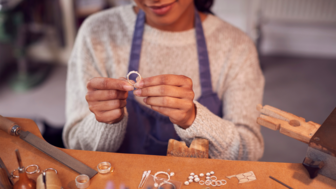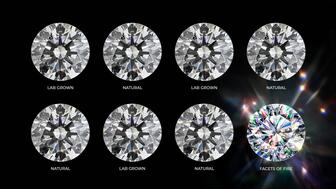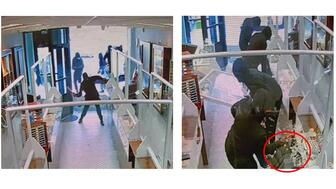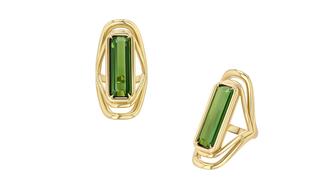The National Retail Federation expects retail sales growth to return to pre-pandemic levels as consumers continue to face inflation.
Rocks On: Rubies and Name Recognition
The future of the ruby market seems to lie with the stones originating from Africa, but will the trade ever hold them in the same high regard as it does the Burmese stones?

New York--Rubies have long sat atop the gem world, serving as one of the most historically significant stones and commanding at times the highest per-carat price of any gem.
Burmese rubies, in particular, always have been regarded with a certain reverence, encapsulating the best the gemstone has to offer.
Yet in recent years the market has had to find a new direction in which to head, as the Burmese material remains banned for import into the United States due to government sanctions and the source itself dries up.
A few African sources, particularly in Mozambique and Madagascar, are offering the gemstone world new supplies that, a few experts say, are on par in terms of quality with the Burmese stones.
What remains to be seen, however, is how long these supplies will last and how long it will take for the market to fully accept them.
Supply
One of the major challenges for the supply side of rubies is the fact that the import of Burmese rubies remains banned in the U.S., cutting off supply to the American market.
Even if the ban wasn’t in place, the Burmese sources for the gemstone have been drying up, which means there isn’t much new material available on the market anyway, according to Benjamin Hakimi of gemstone supplier Colorline Inc.
However, material from Tanzania, Madagascar and especially Mozambique is reviving the ruby supply and can offer high-quality material comparable to that from Burma for a fraction of the price. Hakimi called these African rubies a “lifesaver” for manufacturers, as it is bringing ample affordable material to market.
According to gemstone dealer John Buechner, when Mozambican rubies that were comparable in color and clarity to the Burmese material came onto the market around 2008, they were selling for about one-sixth the price of Burmese rubies. Today, though, “that gap has narrowed and they are about half the price,” he said, though he noted that the stones still offer a great value.
Hakimi, meanwhile, said that he sees the African material at, on average, about 30 percent cheaper.
There’s also a major player involved in the ruby market now, which will have a lot of influence on where the market is headed.
Gemfields holds a 75 percent stake in the Montepuez mine in Mozambique. It received the license to mine the site in 2012 and held its first ruby auction in
CEO Ian Harebottle told National Jeweler via email that the company has targeted production volumes in 2016 to be largely in line with what they achieved in 2015.
In the company’s financial year ended June 30, 2015, production at Montepuez totaled 8.4 million carats of ruby and corundum.
In the following six-month period to Dec. 31, the company said it mined 2.1 million carats of ruby and corundum with a focus on lower grade--meaning its output contains a smaller portion of valuable minerals--but significantly higher value alluvial ore resources. This resulted in a 341 percent increase in overall volume of higher quality rubies recovered.
According to Harebottle, Gemfields also is focused on the short-term goal of continuing to support the downstream market by absorbing the supply while also trying to stimulate increased global consumer demand, as they have done with Zambian emeralds.
The company said that it will continue to provide a base of support across the pipeline, including sales staff training, consumer education and various direct marketing campaigns.
Demand
As of late, there’s been a bit of a slowdown in buying in the Far East, both Hakimi and Harebottle said, with the latter adding that the decrease in demand from the Chinese market has been partially offset by the signs of recovery coming from America.
Even so, demand for rubies, while perhaps not at the level seen for sapphires, is still very high, especially for the higher quality, unheated material. And while U.S. customers might have a much harder time getting their hands on the Burmese material, overseas buyers still are asking for it.
Most buyers these days also are looking for “pigeon’s blood” rubies, especially in Hong Kong, Jeremy Hakimi of Colorline said. “They’re always looking for royal blue (sapphires) and pigeon’s blood (rubies). Maybe not as much here (in the U.S.), but that’s definitely what most people want.”
Buechner predicted that given the (so far) consistent supply of material on the market due to the more recent sources, along with consumers becoming much more educated about rubies and their rarity, demand for the gemstone in the U.S. will continue to rise and so will price.
And given rubies’ long history and staying power, it’s obvious that while demand might dwindle here and there based on certain economic factors, the stone is here to stay.
“The fact that rubies have such a broad-based appeal means that demand is not dependent on any single market, with considerable potential for growth when appropriately supported by improved availability, design, manufacture, distribution and promotions,” Harebottle said.
Pricing
Benjamin Hakimi said that with the introduction of the new material from Africa, he thought that prices for rubies might soften a bit, but they haven’t; prices have remained stable.
Gemfields also is seeing price and demand stability for the stone, as the market becomes more comfortable with the material that is being produced in its mine and seeing its high quality.
Harebottle told National Jeweler that this stability is further being supported by the company’s method of bringing rubies to market--a “highly transparent” auctioning platform where large amounts of high quality rough is offered on a consistent basis that in turn “results in improved economies of scale, broader-based distribution networks and considerably enhanced marketing potential.”
As a result, he said, the company has seen more high-end jewelry houses beginning to work with and promote Mozambican rubies, such as Cartier using a 15.29-carat Mozambican ruby at the center of its Reine Makéda necklace for the 27th Biennale des Antiquaires in Paris last year.
Hakimi too said that with the African material, it’s just a question of traction and how long it will take for the sources to really gain steam with buyers.
The country is putting out a lot of high quality, untreated material, so that’s not the issue, he said.
While there was a lot of buying at first, there’s been a bit of a slowdown since, especially in Hong Kong, which he thinks has to do with the geopolitical environment there. And, it “just doesn't yet have the name” that Burmese material does.
The lead-glass problem
A big issue that’s been plaguing the ruby market for a while now is lead glass-filled rubies. While these stones might have their place in the market, problems have been stemming from non-disclosure.
Since lead glass-filled rubies--which are different from treated rubies--are vulnerable to damage from something as simple as a common household cleaner, if a seller does not disclose the fact that the stone is a “composite” ruby and it later is ruined, that could “erode confidence in gemstones,” Benjamin Hakimi said.
Fortunately, he added, lead glass-filled rubies are fairly easy to identify ahead of time. (According to the Accredited Gemologists Association, one should look for a heavily crazed or fractured surface, flash effects or gas bubbles using a loupe or a microscope.)
Hakimi also noted that these issues surrounding lead glass-filled rubies are creating “headaches and costs” for Colorline because they now need to send “anything substantial” to a gem lab for certification.
Yet this increased need for ruby reports comes with a silver lining, of sorts.
A number of grading laboratories now are including color terminology on their gem reports, which could be good for jewelers because it could “help them quantify a sale,” Hakimi said. Of course, on the other hand, it could also hurt the sale if the report instead includes “vocabulary that’s not appealing” to a buyer who sees it.
“The bottom line is, you have to look at the (color of the) stone and see if you like it,” he said.
With the addition of color terminology to lab reports also comes the issue of consistency--for example, what one lab might consider a “pigeon’s blood” ruby could be different from what another lab might label as such. (This is an issue being addressed by a few labs, including the Gemmological Institute SSEF and Gübelin Gem Lab, which recently harmonized their standards for color and quality terms.)
Meanwhile, Gemfields’ Harebottle also noted another issue facing not only rubies but gemstones on a broader level.
For centuries, gemstones were regarded as one of the highest-valued possession one could have. Yet in recent years, due in large part to increased global communications and marketing, other luxury items--including shoes, handbags and perfumes--also have managed to enter this realm.
Harebottle said there has been more promotion behind such items, resulting in a decreasing market share for gemstones.
This is a large part of what Gemfields is trying to address with its efforts around the stones it mines, and Harebottle remains hopeful for the future.
“We have little doubt that what we have seen to date for emeralds, rubies and, in fact, all colored gemstones, is just the beginning,” he said.
The Latest

The 4-carat, old mine brilliant-cut diamond engagement ring was co-designed by Willis and New York City-based brand Karina Noel.

The multisensory experience, open April 8-13, will feature the brand’s silver creations among dream-like scenes of natural landscapes.

Bench jewelers spend years honing their skills, Jewelers of America’s Certification validates their talents.

The virtual event will take place April 7 at 3 p.m.


The pieces in “Animali Tarallo” portray animals from stingrays to elephants through portraits and interpretations of their patterns.

Parent company Saks Global said the iconic location will be open through the holiday season as it decides what to do with the space.

Natural diamonds mean more than lab-grown, but when every cut is ideal, they all look the same. Customers want more—Facets of Fire delivers.

The educational event will take place in Charlotte, North Carolina, this May.

The independent jeweler first opened its doors in 1888.

The layoffs come amid the TV shopping channel’s efforts to restructure and focus on live shopping through social media.

The debut event will take place in Miami’s Coconut Grove neighborhood this fall.

The roundtable will take place May 17 ahead of the trade show’s welcome dinner.

The “Peanuts x Monica Rich Kosann” collection features the comic strip’s classic vocabulary across 10 bracelet designs.

Three industry experts dive into the complexities of the material often marketed as an “ethical” alternative for metal in jewelry.

Diamonds are not only one of the most prominent gemstones, but the birthstone for those born in April.

The Utah-based company known for making wedding bands has acquired Doubloon Golf.

The longtime luxury executive led one of LVMH’s watch brands, TAG Heuer, for 12 years before taking over Bulgari in 2013.

Authorities said the robbers fled with jewelry and 70 Rolex watches, later taking pictures of themselves posing with big stacks of cash.

Lotus Gemology founder Richard W. Hughes has translated Heinrich Fischer’s 1880 book “Nephrit und Jadeit” from its original German.

The ring's design features contrasting lines influenced by work from architecture-inspired photographer Nikola Olic.

The Conference Board’s index fell as consumers continued to worry about the impact of tariffs, the labor market, and the price of eggs.

However, two medieval jewels surpassed estimates at Noonans Mayfair’s recent jewelry auction in London.

The Oscar-nominated actor debuted in the campaign for the new “Top Time B31” collection, which introduced Breitling’s Caliber B31.

The Congress is scheduled to take place May 19-22 in Brasilia, Brazil.

The family-owned retailer is the new owner of Morrison Smith Jewelers in Charlotte, North Carolina.

The “150 Art Deco” collection features a Miss America timepiece and a pocket watch from the brand’s Archive Series.

















































